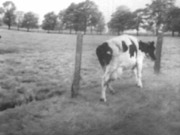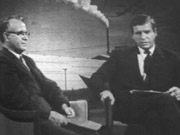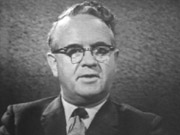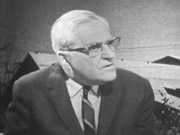The following is the portion of “Air of Death” that deals with fluoride pollution from a phosphate industry in Ontario, Canada.
STANLEY BURKE, CBC: Air pollution isn’t just a big city problem. A new phosphate plant back in 1960 brought a welcome boost to the economy of the quiet agricultural area around Dunnville in Southern Ontario – new paychecks, new life.
Ever since the pioneer days, generations had dwelt in the security and peace of rural living. Pandora’s box was opened. For generations, good cash crops had burgeoned from some of the richest farming land in the country. Pandora’s box was opened.
Farmers noticed it first – the thing that came out of the box.
They don’t like to talk about it, even now. You have to persuade them to tell you what it was that came out of the box.
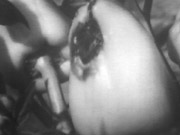 Something mysterious burned the peppers, burned the fruit, dwarfed and shriveled the grains, damaged everything that grew. Something in the air destroyed the crops. Anyone could see it. You can see it now.
Something mysterious burned the peppers, burned the fruit, dwarfed and shriveled the grains, damaged everything that grew. Something in the air destroyed the crops. Anyone could see it. You can see it now.
Let’s go for a walk with one of the farmers, Tony Carl. Let him show you his cucumber leaves. Something came out of the box. Something in the air burns. Look at those holes.
They noticed it first in 1961. Again in ’62. Worse each year. Plants that didn’t burn, were dwarfed. Grain yields cut in half.
He’ll show you his fruit trees. Twenty year old orchard. Trees that produced so richly for so many years, and now for 6 years they’ve given up no fruit at all for market. Random apples not worth picking.
Finally, a greater disaster revealed the source of the trouble. A plume from a silver stack, once the symbol of Dunnville’s progress, spreading for miles around poison – fluorine. It was identified by veterinarians. There was no doubt. What happened to the cattle was unmistakable, and it broke the farmer’s hearts.
Fluorosis – swollen joints, falling teeth, pain until cattle lie down and die. Hundreds of them. The cause – fluorine poisoning from the air. Under arbitration, the Electric Reduction Company (ERCO) paid the farmers $218,000 for the loss of crops and cattle.
Shriveled crops, limping cattle, but now is there a graver development? I asked Joe Casina.
BURKE: And you’re walking with a limp right now?
JOE CASINA: Yes, I had myself examined by a Dr. Marsden, a specialist from Hamilton. [Inaudible] Dr Marsden called me in and he says to me ‘you know Joe, if you got pollution damage you’re going to have an awful time to prove this.’ I told Dr. Marsden, ‘Listen Dr. Marsden, if I’m gonna die from anything, I want to know what the hell I’m dying from.’
[Inaudible]
Dr Marsden says, “there is a case like this in the United States, one in Canada, and I think you’re the third one and I’m going to look this thing over and find out whether this is really it or isn’t it.’ Well I said ‘thank you Dr. Marsden, I’m glad you’re thinking of this in this respect’ and then I left his office.
But I’m really concerned because I want to know what’s the matter with me. If it isn’t this, I want to know it, if it is this, I also want to know.”
————
BURKE: Well I can see that she’s lame, got the deformed hooves. What else is wrong?
FARMER 1: Well, there’s swelling of the [inaudible] and of the bottom parts, like right down here and at the bottom. And also, it affects the teeth. I don’t know if she’s willing to show them now or not. You can see that they’ve got brown stains on them and sometimes they fall out and they lose their teeth as time goes on.
BURKE: Well now you sell this animal to be destroyed. Is the meat eaten?
FARMER 1: Yes, the meat is eaten because it’s been said that the meat and the milk is ok for human consumption.
BURKE: You eat this meat yourself?
FARMER 1: Yes, we do.
BURKE: How do you feel yourself?
FARMER 1: Matter of fact, not too good.
BURKE: How do you feel?
FARMER 1: Well to go into detail I wouldn’t want to say. I got achy joints as well as on the knees and it’s been bothering me [inaudible]. I’m under investigation by the Health Department right now.
BURKE: What do they tell you?
FARMER 1: So far there has been no results as of yet.
BURKE: But there are a lot of other symptoms around here. I noticed looking at your trees for example.
FARMER 1: Oh trees, and it affects your grass and grains and scrubs as well. Most anything that grows around here is affected by it.
BURKE: How much is your production down?
FARMER 1: It’s down about 30 percent over last year.
BURKE: How long can you keep on going at this rate?
FARMER 1: Maybe next year, yet maybe not even that long.
——–
BURKE: Well now specifically, yourself, how are you feeling? What about your family? What about your neighbors?
JOE CASINA: Well, myself, I’m not feeling like I should feel. I’ve not felt right since spring. But being a farmer, you lay on it over the wintertime, you take it easy, you think you got a break in at the spring, and you feel these little aches and pains, and it’s normal. But then when my feet started to swell, I thought it wasn’t normal. And I went in and had a little [inaudible]. And I’m still not right. I still have plenty of nights that I don’t get enough sleep due to the fact, the pain. And I, I don’t know. The doctors don’t seem to know what it is.
————
BURKE: Well, what about you, your own children for example? Doesn’t this bother you?
FARMER 2: Personally it does. Real serious. And we can’t get a…all we’ve been told is that for the amount of consumption that a human eats of food that’s produced in the area, it represents such a small percentage that you won’t get enough to harm you. But we’re also told that gardens in the high contaminated areas, there was some products in them that were unfit for human consumption because of the high fluoride content in them.
BURKE: Such as what?
FARMER 2: Lettuce, cabbage, some of these open leaf type vegetables.
——–
BURKE: What’s wrong with that plant?
TONY CARL, FARMER: Well first we can’t get the proper growth out of our plants anymore. See this is only half the growth here on this plant. Peppers should be 3 feet high this time of year with the good season we had this year and look at this here, this is burned. One side is burned completely and the other side is partly burned. So this is all scrap. But you check this plant and there’s quite a few in here that aren’t worth, you know, there’s nothing healthy on this plant at all here.
BURKE: What do you think about these crops around here, this corn in the field next door for example, should you be growing in your opinion, should you be growing these crops? Should you be sending them to market? Are they safe?
TONY CARL: I wouldn’t know. I’m not in a position to answer that, you know. I think sometimes my vegetation shouldn’t even go on the market, but I gotta make a living out of this.
——-
BURKE: How many of you people are out of business here now?
FARMER 2: Well, there’s 8 cattlemen that are out of business for sure. There’s Tony Zinnermerski, Peter Kerkin, there’s Peter Shalatowski, Mr. Vanderbeek, Altow brothers, John Caruthers, Keith Wright, myself. We all had cattle, and nobody has any now.
——-
BURKE: What about the company men?
JOE CASINA: They never tell you it’s fluorine. Until 1965 nobody mentioned fluoride. In ’65 when the cattle went down, then they started to. There was a buildup of fluoride in the cattle, a buildup. Then they didn’t know if it was built up in the vegetables or not. But they said it was built up in the cattle. The cattle went down. In fact, they went down so bad, I’ve seen cattle laying in the field that couldn’t get up. They had to tow them out of the field with tractors.
BURKE: Here’s a dead leaf. I mean, can’t you take that into the lab and analyze it? And, what’s in it?
JOE CASINA: Well, we’ve sent leaves away. But we never get an answer on it.
——
BURKE: What’s the company tell you? Do you have any meetings with company representatives? What’s your relationship with the company?
FARMER 2: We just get a mum word whenever we talk to the company at all. We don’t get any response outside of promises that they’re going to clean it up. This year they’ve been as quiet as mice.
——
BURKE: We went to the ERCO plant where employees said the problem is being controlled. There’s nothing to get excited about. They weren’t prepared to admit that there’s any problem.
BURKE: [As] an employee or as a resident of the area, what are your reactions?
ERCO EMPLOYEE: As an employee, I got no comments.
BURKE: As a resident?
ERCO EMPLOYEE: As a resident, personally, I don’t think it’s a big problem, but I don’t wish to comment one way or the other. I have my own opinions but I don’t wish to express them.
BURKE: We’ve seen crop damage that we know, I mean, that can be recognized as specific fluorine damage, marks on the leaves. We’ve seen cattle with their teeth falling out.
ERCO EMPLOYEE: How can you say that? I could take you to my front yard and show you trees and so on. I have 4,000 acres down on the other side of Peterborough and I was down there on the weekend and there’s all kind of attack down that area. It’s sure the hell not fluorine.
BURKE: But not cattle with fluorosis. Now this is a disease which can be specifically identified.
ERCO EMPLOYEE: Could be.
BURKE: It’s true.
ERCO EMPLOYEE: All right. I’m not…
BURKE: Is it coming from here?
ERCO EMPLOYEE: Well let’s put it this way. There is fluorine coming out of those stacks. We even admitted it. We know there is. But a small amount.
BURKE: I have in the studio here Dr. Diamond, the Ontario Provincial Minister of Health, and we had hoped to have a representative of the ERCO company. The company declined the invitation however.
Dr. Diamond, this is of course a local situation, a specific one, but we think it’s a very good example of the sort of problems you can get into in air pollution. What are your reactions?
DR DIAMOND: Well, this is of course a local problem and fortunately it is not the kind of a problem encountered very often throughout the province. I recognize that this came to light only very recently, that effort has been expended in seeking to control it. But it was rather a staggering revelation to find that something of this kind could be going on and there was little knowledge about it at the time, until the damage was done and investigations were started. We recognize that this is part of the whole problem of controlling people’s environment.
BURKE: Well, now this is a question I would have preferred to put to the company representative, but here’s a book on air pollution put out by the World Health Organization in 1962 which goes into this specific phosphate fluorine problem and it came up prior in other places before this plant was built. But even so, it’s been going on now for seven years. Should it have been allowed to develop, and specifically, what is going to be done about it? The farmers have told us that you have said that if it can be shown that there is damage to human beings, to health, that this plant will be closed down.
DR. DIAMOND: No, at no time have I said that the plant will be closed down. Very definitely, if the damage, either to human beings, to plant life, or to animal life, continues, or if damage to human health is demonstrated, and there is no way of controlling the pollution, of course the plant would have to be shut down because life is far more important than anything that comes out of any plant. I’m quite certain that some substitute could be found for the product that is manufactured here. But so far this has not been demonstrated. We know there has been plant damage, we know there has been damage to animal life. We are very much concerned, for instance, about the complaints now that we hear from people about differences in their own health. And this is one of the matters that will be very quickly submitted to extensive and intensive study. But we also know that there are ways of controlling fluoride emissions. The company, I believe, has controlled this at least to 90 percent of the emission. That 10 percent is still in our view too much to be allowed to flow free in the air and this too will be brought under control if it is at all possible. If not, then we have to look at other ways of controlling the problem.
BURKE: Well, Dr Diamond, just a moment ago you expressed concern about the health issue at Dunnville. Now we asked a specialist in fluorosis, Dr. Waldbott of Detroit, to go to the area. He saw 9 of the farmers and he found that 2 seemed to be suffering from fluorine intoxication. And here now is what he had to say to our producer Larry Gosnell:
DR. WALDBOTT: This disease is characterized by joint pains, by headaches, by gastric and intestinal disturbances, by bladder disturbances. In the area where I saw these two people I noticed mainly arthritis in various parts of the body, particularly in the lower spine.
GOSNELL: What’s going to happen to these people who have fluoride poisoning if something isn’t done for them?
DR. WALDBOTT: If they are taken out of their surroundings, this disease, according to what I have learned, will clear up by itself. But if they continue to live in this area, eventually they are going to get more serious harm, serious damage to their joints, to their internal organs, particularly to their kidneys, and also to their brain and to their spine, which eventually will lead to death. As a rule, the immediate cause of death is pneumonia or it is damage to the kidneys – pyelitis, pyelonephritis.
GOSNELL: With where we are right now, can you tell me your own personal opinion about the responsibility of the officials in this whole question?
DR. WALDBOTT: Of course, if I would give you my own frank opinion, I feel that the government officials who should look into this matter carefully and should particularly be guided by scientists not connected with industry, they have fallen down on their job.
GOSNELL: Dr. Waldbott, what would be your advise to these people who are suffering from fluoride intoxication?
DR. WALDBOTT: First of all, they should be hospitalized and more thorough and more conclusive tests be carried out. And furthermore, the thing that has to be done to cure these people is either to eliminate the pollution of the air or to have them move, leave their farms, and move into an unpolluted area.
BURKE: Can you give me your reaction to this?
DIAMOND: This, this is very interesting, but neither as Minister of Health nor as a physician would I comment on a very brief report of that type. First of all, I recognize that Dr. Waldbott has done a very great deal of work in the study of fluorosis. He’s probably one of the most extensively quoted authorities, he and I believe a colleague are among the most extensively quoted authorities on the continent and maybe in the world on this matter of fluorosis, and doubtless have far more knowledge of it than I would have. But fluoride isn’t the only cause of arthritis, arthritis is one of the most common degenerative diseases to which humanity is subject. And I would be most loath to come to any conclusion, any clinical conclusion on the basis of a report of that kind. I agree with one thing that Dr. Waldbott says there, that these people who are complaining of difficulty, painful and aching joints, should be hospitalized or should be subjected to the type of study and investigation which their attending physicians believe is essential to diagnose their problem. Again, I have to emphasize that fluorosis is not the only, nor the most common cause, of painful and swollen deformed joints. It might very well be, I don’t want to minimize the possibility of this being a factor, nor will I concede that it is a factor because I don’t know. I say to you that now under our air pollution act we have the power and will take the authority to institute intensive and extensive studies to the end that we will try to determine how much human health is damaged by this pollution.


